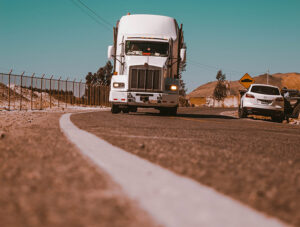

A nasty scratch on a car in the store’s parking lot: things like that can happen. Was it the truck driver’s fault, or are we putting so much pressure on our logistics chains that we are basically asking for accidents to happen? “Trucks don’t tip over on their own.”
With the warm spring sun, we’ve already nearly forgotten that it was winter, but back in early February we had a bit of black ice. That day, a number of freight trucks slid and jackknifed on the freeways. Those trucks were headed to stores in the early morning, filled with our “daily bread”. They didn’t stand a chance.
“Trucks don’t tip over on their own”
We often complain about accidents with trucks. When those happen during rush hour, they lead to frustratingly long traffic jams. Mathieu Weggeman, a professor of organization science at the Eindhoven University of Technology, held an angry diatribe against the numerous traffic jams around Eindhoven caused by accidents involving trucks: “Trucks don’t tip over on their own.” In his view, the transport sector was the culprit. The truck drivers need to be called to account. But is Mathieu Weggeman right in this regard? What do we actually know about the real causes of accidents?
Transport companies are obviously concerned about the accidents and any damage done. Transport insurance premiums are rising steadily in a sector that is already struggling due to the low margins. These days, a transport company pays about 2% of its turnover to insurance companies. More attention needs to be given to safety in the transport sector, on freeways and within cities.
Vision Zero
Trucks are becoming safer and safer thanks to all their advanced technology such as anti-tilt systems, lane assistance, adaptive cruise control, anti-blind-spot cameras, an orderly infrastructure and – soon – platooning. So how can we manage to eliminate fender benders on the road? That is what ‘Vision Zero’ is all about.
Technology alone is not going to be enough, of course. How many trucks loaded with construction materials aren’t making “first-work-first” deliveries during the early morning rush hour in congested city centers? What were those trucks doing on the road in that fog in Zeeland? And what were those trucks with food products doing on that slippery freeway so early in the morning? They were all on their way to customers who were in a hurry: get out of the way, move to the side – and all that to cut costs with the meager rates that shipping companies are willing to pay.
Supply chain agreements
More transport safety begins with safety in the supply chain. Are shippers and receivers agreeing on terms that are both feasible and safe? I will be curious to see if one day soon there won’t be big data about transport accidents and damage, about the particular logistics chains in which those take place, and about precisely where in those supply chains such accidents most often happen. That could well be a real eye-opener, allowing shippers, carriers and receivers to work further together with a “Vision Zero”: zero accidents and zero damage. Transport safety begins with safety in the full supply chain.
Walther Ploos van Amstel





